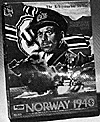
Quarterdeck Games
P.O. Box 658, Cambria, CA 93428
Released: February 1985
Price: $22.00
Complexity: Intermediate
Solitaire Suitability: None
****
Norway 1940 is an operational-level simulation of the German attack on Norway during World War 11. This game was originally produced in the U.S. by Quarterdeck Games but went out of print. The edition reviewed is produced by Hobby Japan under license from Quarterdeck Games. The game comes complete with the original Japanese rules and charts. The map and counters are in English, which seems strange for a game distributed on the Japanese war-game market. Quarterdeck Games, the importer, includes a set of rules in English (which are actually the original rules) and game charts.
The production of the game is first class. A mounted map is provided for each player. The counters are well made but hard to read due to the small type size. The overall visual effect is pleasing. The Rodger MacGowan box art is, as usual, very attractive and an attentiongetter on the store shelf. Overall, the game is an excellent product and well worth the $22.00 retail price.
The game system employed in Norway 1940 is essentially a double blind system: one cannot see one's enemy openly on the game board. One must search for the enemy and discover his whereabouts. A whole new dimension of gaming opens up as one must fight the "fog of war" as well as the opponent. This system for naval games has been around for years. Its use is welcomed for adding excitement and simulating the actual hideand-seek of the actual campaign.
One of the best aspects of the game is that the German victory conditions are secretly determined at the beginning of each game. Victory may hinge on exiting selected German capital ships from the board or invading Norway. The victory conditions also employ victory points for damaging and destroying enemy ships. The Allied player doesn't know the German victory conditions so a deeper fog of war soon develops around the game table. A player not used to such conditions can become quite fearful of what may be out there in the North Sea.
Play proceeds via game turns, five in total. Each turn (one day real time) consists of three daylight and two night turns. Within each daylight or night turn there are five action phases: reinforcement, movement, German air reconnaissance, the ship search procedure, and combat. All ships are moved secretly and simultaneously. Both players then search for the other's surface ships by calling out hexes where the searcher has ships, submarines, or air reconnaissance. The German player may additionally use his air reconnaissance capacity to search any three hexes for Allied ships. If an enemy surface ship is present in the searched hex, the contact is resolved and any combat that is called for is conducted. Combat can consist of submarine vs. ship, aircraft vs. ship, or ship vs. ship.
Air movement occurs only during the combat phase as aircraft may be shuttled from carrier to land bases and vice versa, carrier to carrier, air base to air base, and finally vectored to potential targets. Land combat is limited in this game and is confined to the capture of Norwegian cities and airbases. The assaults are resolved via a simple combat result table (CRT) that is limited to either capture, repulse, or roll-again results. It is simplistic, but the real battle for Norway was fought on the high seas and it is here that the combat system shines.
The search procedure prior to naval combat is well handled, with evasive action and shadowing both possible. if the enemy is actually located, a battle or combat round will occur. During combat, submarines, aircraft, and ships that have managed to locate the enemy, are allowed to attack. Air cover can even be used to abort incoming air attacks. It's all here in a playable format.
Ship-to-ship combat can result in flotation and gunfire hits and, in some cases, torpedo attacks. Gunfire can cause special damage and critical hits. Overall, it is a welldesigned and viable combat system.
The game is fun to play and adequately reflects the historical reality that occurred in the Spring of 1940. The designer has mated playability with a relatively detailed but simple design into a well-balanced game. Game strategy revolves around the search procedure. The British must attempt to locate the German forces as quickly as possible and bring him to battle with his stronger force. The German must avoid detection and battle for as long as possible for his victory conditions to be achieved. The decision on how to divide one's forces is critical. A naval force must be strong enough to defend itself, but deploying large task groups cuts clown on the area that can be searched. It is a cat-and-mouse game with deadly consequences for the player who misjudges.
In summary, the game is one of the best naval games on the market today, it combines a good game system with a tense historical situation to make for an enjoyable afternoon or evening of play. There is enough chrome such as leader quality affecting detection results, detached destroyers, Force Wilfred, and weather to make just about everyone happy with this game. In conclusion, where else can you find a game that lets you use Blackburn Skua dive-bombers to sink the Bismarck?
More War Game Reviews
-
Game Review: Norway 1940: The Kriegsmarine Strikes
Game Review: Crusade in Europe
Game Review: Star Fleet Battles Supplement #2: X-Ships
Game Review: Thunder At Luetzen: Opening Battles for Germany 1813
Back to Table of Contents -- Game News #8
To Game News List of Issues
To MagWeb Master Magazine List
© Copyright 1985 by Dana Lombardy.
This article appears in MagWeb (Magazine Web) on the Internet World Wide Web.
Other military history articles and gaming articles are available at http://www.magweb.com